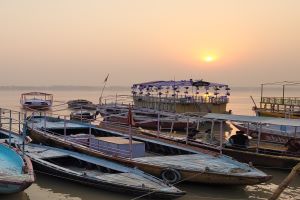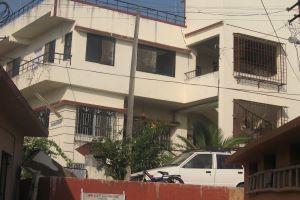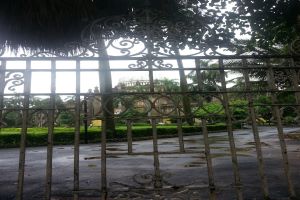Introduction
Varanasi is a sacred city with multiple avatars, almost reminiscent of the various reincarnations of the deities that dwell within it. Originally known as Kashi, it has also been famously nicknamed the City of Light. Banaras is an ancient Indian city that dates back 3000 years. Today, it boasts a population of 1.1 million. It is situated on the banks of the Ganges, a storied river said to have spiritual powers. The Ganga has been revered, not surprisingly, for centuries. Banaras is also one of the oldest living cities in the world, having served as a cultural mecca and destination for religious pilgrims, for over 3000 years. In fact, Mark Twain once said, “Banaras is older than history, older than tradition, older even than legend, and looks twice as old as all of them put together”.
In this post, I will begin to scrape the surface of Kashi’s spectacular glory. For approximately 4 days (Thursday-Sunday), my family journeyed through the spiritual center, discovering the city both through a native’s eyes, as well as enjoying it from the perspective of a tourist (the perfect balance). There are some places that you feel a genuine and immediate connection to, and Kashi is one such place to which I felt a strong magnetic pull.
The purpose of this series of posts is to recollect and share certain memorable moments, learnings and facts from our trip to Varanasi. It shall be a four-day itinerary which will include two days living along the holy river Ganges and two days situated within the city center. This was a brief section of a trip totaling a fortnight (10/14-10/30) including time spent in Pune, Mumbai and Mulshi Hill, Maharashtra. Please sit back, enjoy and buckle in for a whirlwind journey through time, culture, art, history and spirituality. Banaras Awaits…
The First Two Days
In this particular section, I will narrate our first two days navigating the city of lights: our time in Banaras. This trip has been anticipated for several years, and in complete honesty, I am still in shock that it came to fruition! My last visit to this divine, holy city was as a young child in December 1995, when I visited my maternal grandparents, who lived in a bungalow within the Banaras Hindu University (BHU) campus, at the time. My grandfather was a professor at the institution’s department of Metallurgical Sciences.
Our flight from Mumbai (logged in at ~2 hours) arrived in Varanasi around 3:30 PM local IST. Once we landed and had gathered our belongings/ checked-in bags, we made our way outside. After some time, we spotted our guide in the crowd gathered before the airport. We were greeted by an unlikely pair: Our tour guide was a middle aged, portly, short dusky-skinned man who rarely showed a trace of emotion and our driver was a young sprightly baby-faced 20-year-old with a perpetual smile pasted upon his face (what a stark contrast!). The guide stood holding a thin paper sign inscribed with our last name “Jalukar”. These two gentlemen were to assume the roles of our acquaintances and pals for the next 4 days!
We entered a large 8-seater van with an expansive trunk, and settled in for the hour-long ride to the banks of the holy river. Our guide sat in the back seat as there were three rows, and we departed once our luggage was all accounted for. As we drove through the city, I noticed, surprisingly, that the highways were not as packed as in Pune. The ride, therefore, was enjoyable, and less exhausting. We passed several old homes, storefronts and small gulleys as we grew closer to riverfront. Moreover, as we neared the ghats (read: Banaras’ ghats are the flights of stairs leading to the river) in the city’s heart, Varanasi’s true colors began to reveal themselves. Moreover, the traffic steadily grew until, finally, we found ourselves in the midst of a standstill jam! Along the route, we briefly stopped by my mother’s old school: St. John’s School BLW Varanasi to snap a nostalgic photo. Finally, as our van traveled through the usual Indian road craze, we found ourselves at our destination. Due to some booking-related issues, our party of four was divided into two pairs. Two occupants would stay at the Ganges View Varanasi (where I stayed) and the other two at the neighboring hotel, Palace on the Ganges. Both hotels offered above average ambience, hospitality and proximity to the river.
After some time spent checking in, with none other than the hotel owner (more on the hotel’s history below), my brother and I began the ascent to the hotel room.
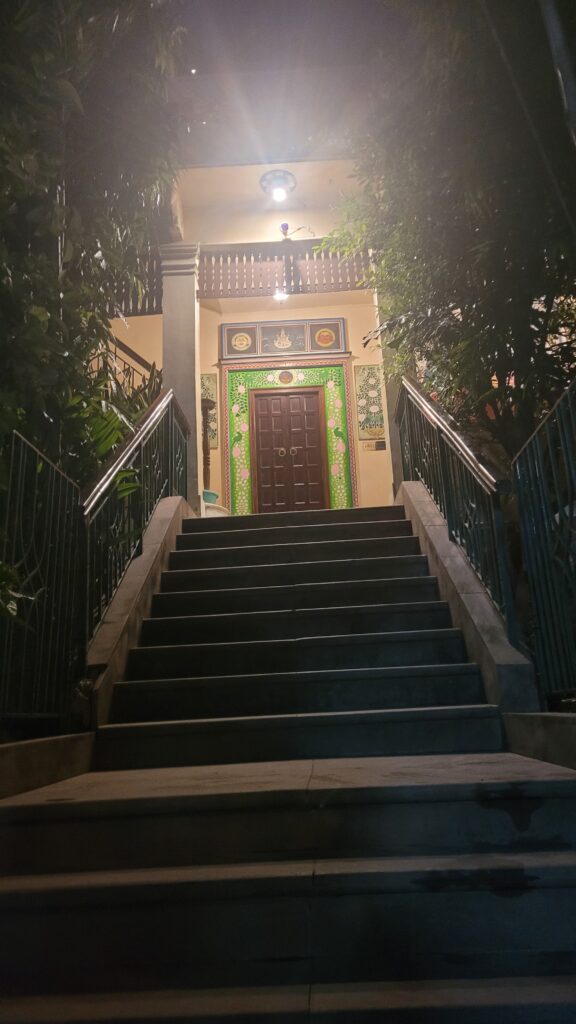
Brief History: Ganges View Hotel, Assi Ghat
The hotel where we had the good fortune of spending two nights has quite a fascinating history! Actually, prior to 1990, the hotel was an operational haveli: that is, a royal palace that was the home of Dulhin (Princess) Radha Dulari Kunwari, of the Sursand state of Bihar, who bought the land on which the hotel stands from Kashiraj Prabhu Narayan Singh in 1903. After being passed through the hands of several members of the Singh family, the private residence eventually became the hotel it is today, in 1990. It is an extravagantly decorated hotel, consisting of large sitting areas facing each set of rooms, 2-3 ganges-view garden patios and an amazing rooftop terrace with additional 360-degree views of the river.
Below is a brochure with additional background information on the unique vintage property.
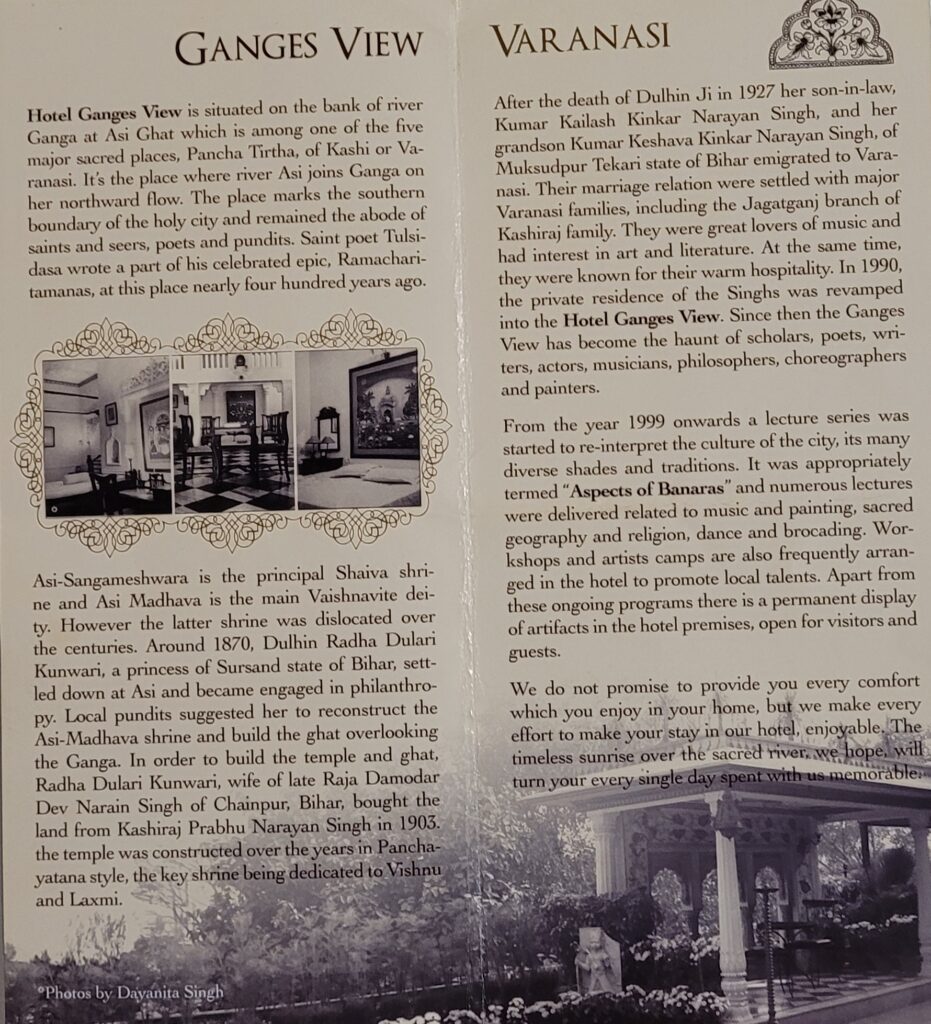
As we made our way up to our rooms, we came up to a platform with a garden and terrace. I stopped for a moment to take in the mesmerizing view of the flowerbeds and Ganges just beyond! I made my way to the iron bar along the periphery of the terrace, and became breathless as I came upon the view of the Ganges (see below). It was incredible! Truly beyond words… Reluctantly, I tore myself from the view, promising myself I would return later that evening… Below is a photo of this breathtaking bird’s-eye perspective of the banks along Assi Ghat.
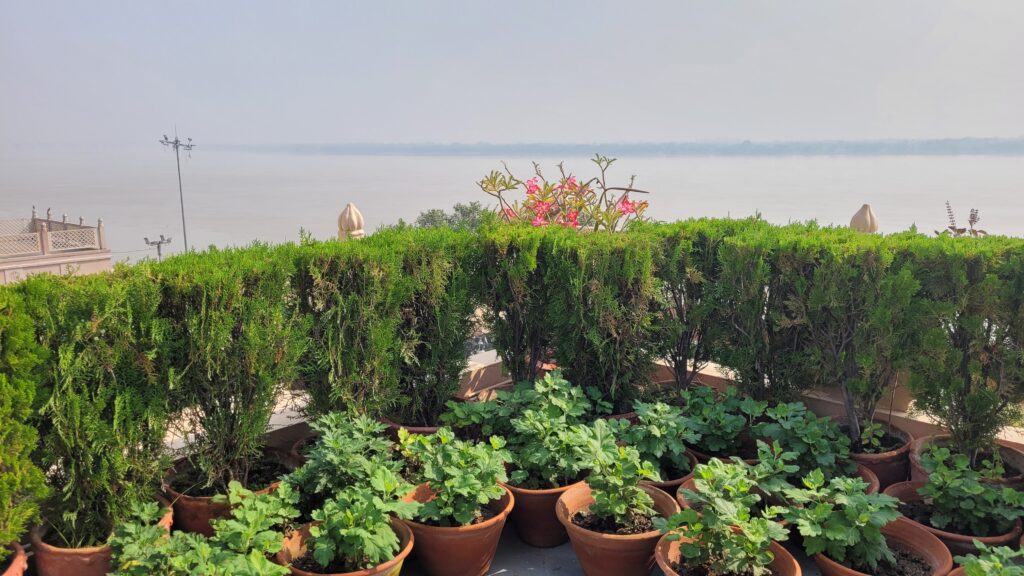
At this point, we climbed the final few flights of stairs and found the wooden & stained-glass doorway to our hotel room.

We spent the next hour freshening up and relaxing in our hotel room, and then stopping by a small streetside convenience store to pick up an ayurvedic pain gel like amrutanjan, which is used to treat headaches (The sensory overload in India is real)!
A Night Time Stroll Through Assi Ghat
As an ebony veil enveloped Assi Ghat, we ventured out of the hotel to begin to explore our surroundings. To provide a little bit of context, Assi Ghat is the southernmost of the 85 ghats that make up the soul of Varanasi. A special feature of this ghat is the open-air Shivalinga and Hanuman Shrine. It is considered good luck to take a dip in the waters of Assi Ghat. That starry Thursday evening, as we strolled along the banks, we caught sight of a varied streetscape: sidewalk vendors selling trinkets, mala bead chains, strings and jewelry, chappals and colorful gems; poverty-stricken children (perhaps as young as 8 years old!) traveling in small groups of three or four, selling a number of items, such as tiny drum-like instruments and toys. Although it was particularly heart-breaking to see, we chose to purchase a diya to release into the river Ganges from one of these youngsters. Their eyes lit up, as they pocketed the few rupees they earned from the sale; but they then began following us to purchase more for about 20 minutes afterward! It was a spiritual experience to light this lamp, dip my fingers into the Ganges and set it into the holy river: a poignant memory which I will forever cherish!
For much of then remainder of the evening, we simply spent time absorbing the truly bewildering scene. It was like nothing I had seen before: rows and rows of colorful yellow, green and blue painted old wooden rowboats docked along the banks, tea stalls peppering the stone streets and stairways, priests and holy men (sadhus) settled cross-legged along the sides of the streets, were just a few notable sights. One unique occurrence from that evening was the opportunity to view the night-time Ganga Arati along the river. Although the photo below will certainly provide a clear glimpse into this ceremonial rite, here is a short descriptive account.
The Ganga Aarti is a daily ritual, which occurs along several ghats on the Ganges. Some ghats host nightly aartis while others host early morning aartis. An aarti is a Hindu religious ceremony wherein priests chant various prayers and offer gifts of light to the Ganges by releasing clay diyas into the waters. Our vantage point for viewing this hour-long ceremony was within a row boat situated in the waters (see photo below): it was truly so unique (the first of many such experiences to come in the next few days). After the night aarti, we decided to return to our hotel rooms and get some sleep. For dinner on the first night, we ate something simple, then retired to our hotel room early as the following morning’s plan was to meet our guide for the morning Ganga Aarti at dawn (5:00 AM!).
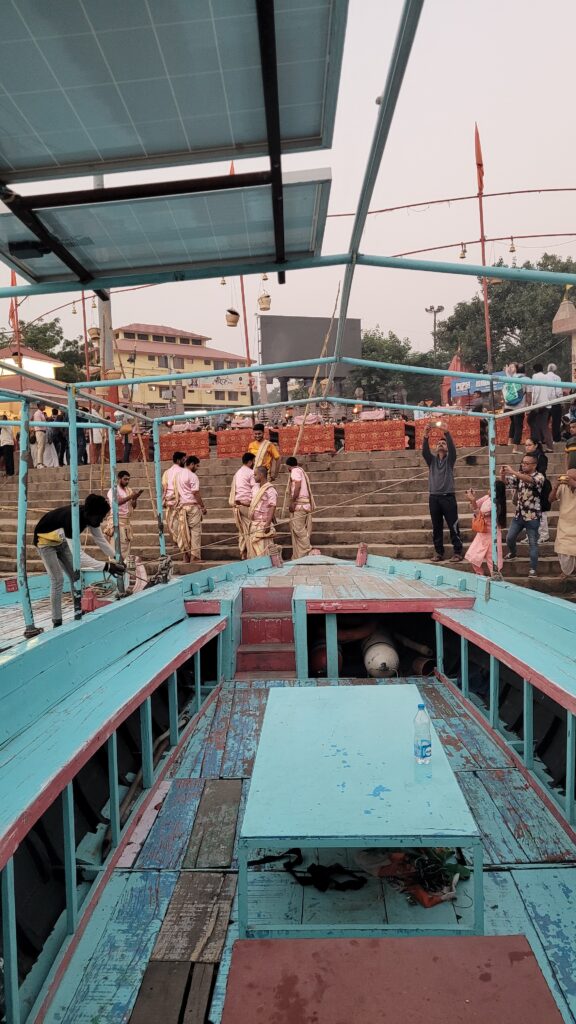
Subah-E-Banaras: Morning Ganga Aarti
There is nothing quite as spectacular, incredible, mystical and peaceful as the early morning hours, which offers the most divine portrait of the sun, as it rises against a serene blue-grey river. Part of the magic of our second day in Varanasi: the Holy City, was the chance to be privy to such a grand morning delight. I live for such moments, those which are wholesome and enrich the soul. We spent a few hours marveling at the aarti’s processions as the starry sky gradually morphed into a brightly lit one. It was rejuvenating, inspirational, and made for an invigorating beginning to the day…
Although technically the second day, Friday was our first full day touring the holy city of the deities. We awoke at dawn, and unbeknownst to our party of four, we were to encounter a most spectacular visual, emotional and spiritual treat. The ganga aarti is a daily affair which is extremely principled and defined by a set of routine rituals, including the chanting of mantras and preparation of large diyas (seen below). The aarti was viewable from several row boats situated within the river. It is imperative to note that we viewed this spectacle from Assi Ghat, which is also where we resided for these first two days.
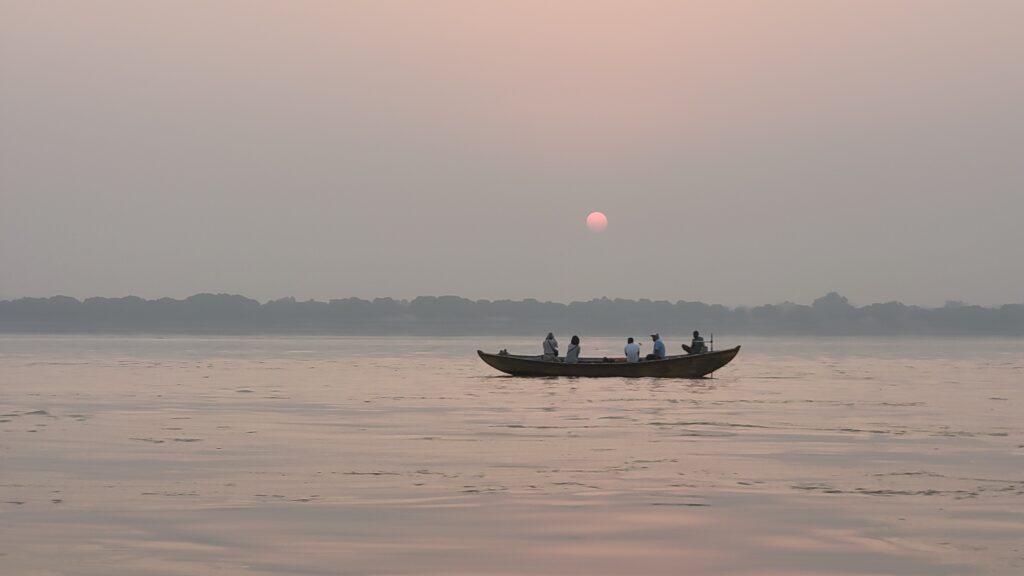


A little more history on the morning Ganga Aarti: Initiated in 2014, Subah-E-Banaras and the Ganga Aarti at Assi Ghat occurs every dawn on Assi Ghat. Although Subah-E-Banaras also refers to the musical program taking place , the Ganga Aarti consists of seven priests chanting vedic verses, followed by the “ceremony of lights”. Although free to attend, many attendees offer flowers, sweets or prasad to the gods. The Morning Ganga Aarti is a divine ritual which gives pilgrims, devotees, tourists and onlookers alike the gift of enlightenment. Following the aarti, attendees wave their hand over the candle flame lit in the diya to obtain blessings from the gods.
Cruising along the Ganges
Following this experience, we embarked on an hour-long cruise along the Ganges. What a wondrous ride it was! The breeze as the boat sped through the waters was extremely refreshing! Below are a few pictures of our cruise. We were able to capture several gorgeous photos both of the boat itself and of the ghats from the waters.
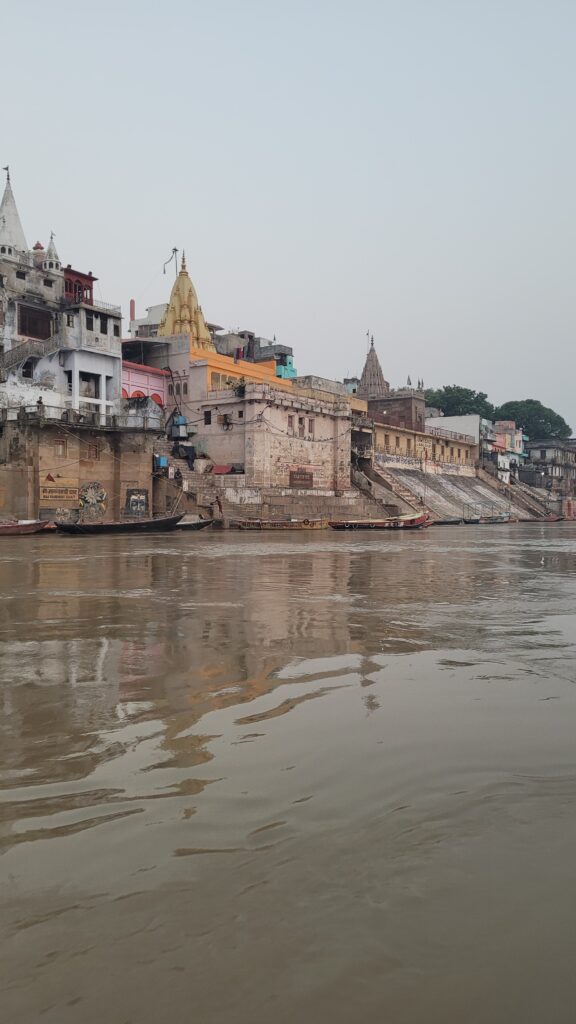
After our cruise, we circled back to Assi Ghat, where, by this time, the classical music program (Subah-E-Banaras) had begun. We took a short break from our plan to enjoy the young singer’s melodious voice, before we set off in search for a nice streetside place to dine.
Lunch Break
The street food in Varanasi is famous: and my foodie family wanted to try all of the unique snacks we could! For our first lunch, we tried Jalebi, Kachori, and a tasty vegetable curry composed of peas and spinach. Below are some photos of our meal!
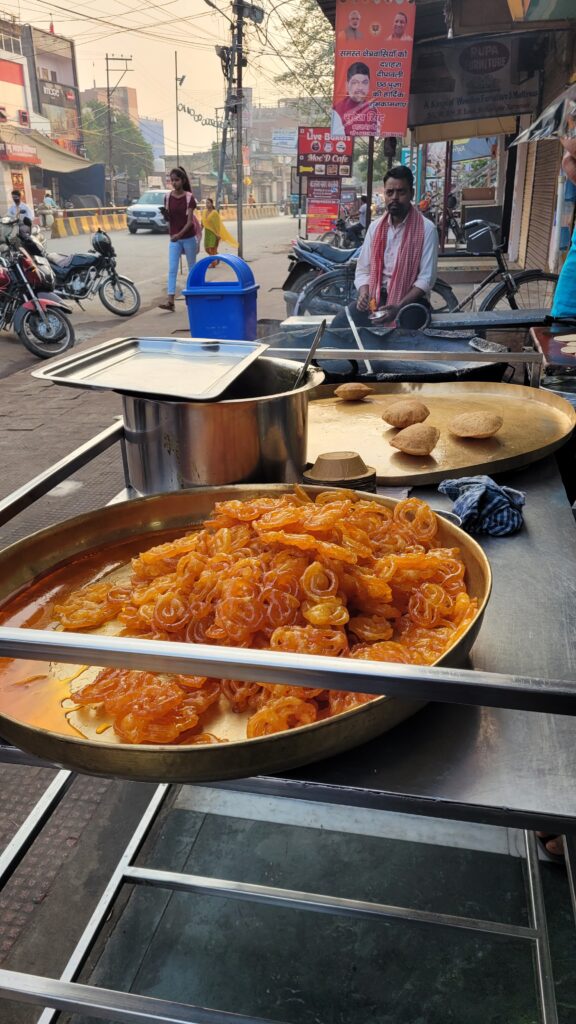
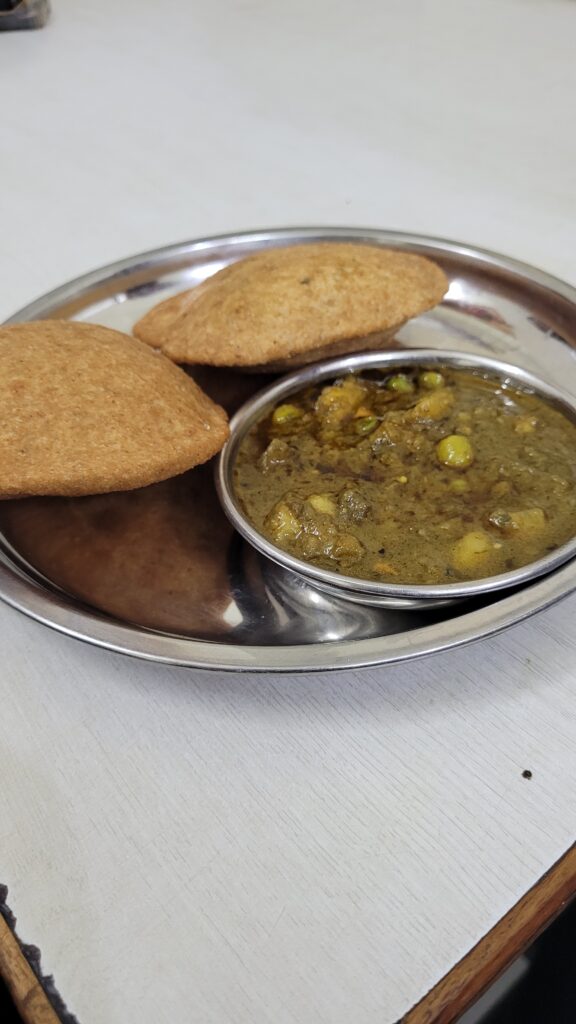
Visiting a Local Bungalow
The rest of our Friday afternoon was particularly eventful, as we were to pack in tours of both Banaras Hindu University (BHU) and Ram Nagar Fort, before returning to the river for the evening Ganga Aarti at Dasaswamedh Ghat. We stopped by our hotel for a short respite, before visiting a a local’s home!
My mother spent the first thirteen years of her life in Varanasi, so in a way, our trip served as a homecoming for her. After lunch, my mother decided to visit her old childhood home. This fulfilled a dual purpose: feeding her nostalgic desire to see the place she grew up, while also introducing our family to the home’s occupants (who still reside there!). We spent an enjoyable hour meeting the family, which, I must add, owns an absolutely beautiful three story bungalow with a garden terrace. I also learned that they have a booming sari business.
As we explored the home, my mother noticed several major renovations which had been made since the 1970s, so it was not the same as when she was a child. Still, it must have been priceless to return to the site where she must have made so many wonderful childhood memories. Following the house tour, before we left, the family treated us to a local sweet, Makhan Malaiyo, “the winter delicacy of Varanasi”, and an exotic fruit bowl including papaya, zebra fruit, watermelon and grapes. Indian families are quite warm and inviting, indeed!
Then, after another quick trip to our hotel, we departed for BHU with our guides…
Touring Banaras Hindu University (BHU)
Founded in 1916 by Pandit Madan Mohan Malviya, a great nationalist Indian leader, BHU initially began with the Arts College, Physical Laboratory, Power House, Engineering College. Since then, it has steadily grown to become one of the top universities in North India. Today, it is designated as an IIT, or Indian Institute of Technology, which means that it reigns supreme, attracting the “cream of the crop”, so to say. The university has also always been a trail blazer, of sorts. For example, it was the first to offer a course in pharmaceutical sciences.
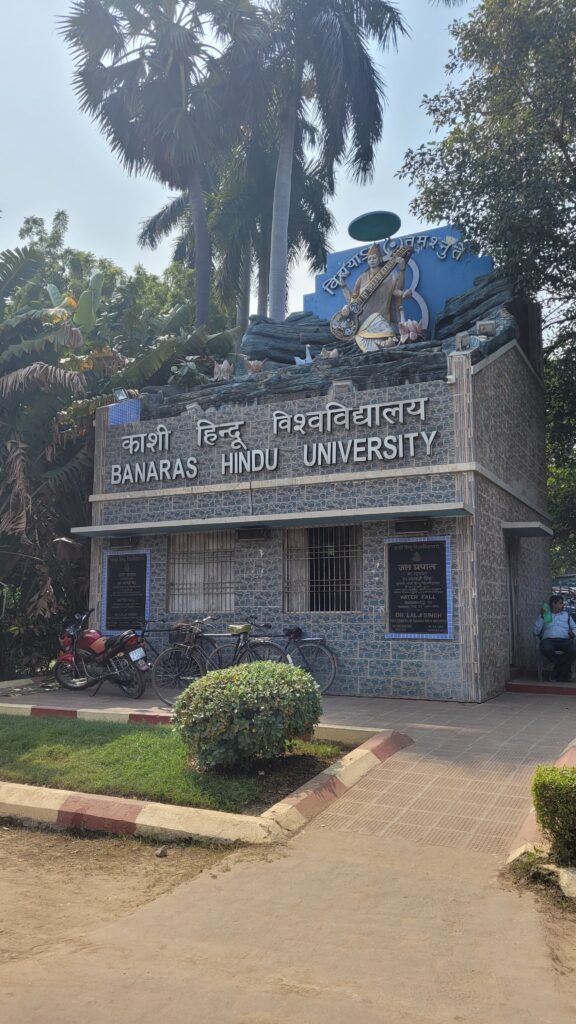
Today, IIT BHU holds the rank as the “largest residential university in Asia”, with 30,000 students, 18,000 of which reside on campus grounds.
Since my mother is an alumnus of this institution, and my maternal grandfather taught in the Metallurgical Science department for several years, seeing the university grounds was at the top of our itinerary for that afternoon. However, even for those without a personal connection to the institution, it is worth a trip, because the campus is pretty well groomed and very scenic.
We spent a couple of hours exploring the university grounds: Our first stop was the Department of Electronics Engineering, which was my mother’s academic home for 4 years. We then visited the Department of Metallurgical Sciences, where my grandfather spent some of the most monumental years of his career, teaching and touching the lives of hundreds of students, and earning the distinguished professor department award.
As we wandered through the campus that afternoon, I was reminded of my college years! After we had walked through the buildings, pausing for some time at the laboratories where my mom clearly has such fond memories, our driver took us to a tea stall for a quick snack and drink break. We consumed delicious samosas and piping hot chai served in clay cups, while standing in the midst of a crowd of at least thirty 20-something college students chilling between classes. Oh to be that young again!
Exploring Ram Nagar Fort
Next on our agenda was traveling to the auburn-red sandstone Ram Nagar Fort. A little snippet of history: Built by the 18th century ruler of Kashi, Maharaja (King) Balwant Singh, the fort was the royal family’s home for generations. Located upon the Ganga’s river bank, the beautiful fort, today, hosts school groups, tourists, and those interested in a little imperial history. Although the royal family does not currently reside there, and their living quarters are not on display, a tour will take you through exhibits filled with a variety of historical items, vehicles, and other pieces, including old Model-T cars (from Detroit!), ancient palkhis which carried the princesses/queens of the past, old trinkets that the members of the royal family owned, pieces of armor, and more.

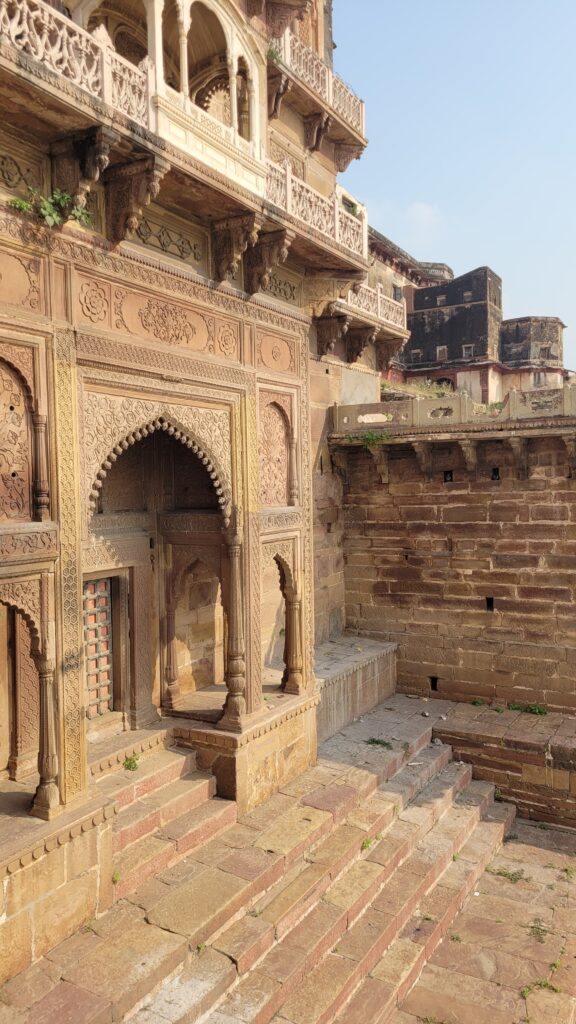
After viewing these vintage artifacts, we strolled through the palace grounds, finally returning to the Ganga located behind the fort. We spent a few meditative moments gazing into the great Ganga’s waters, before we departed the fort and returned to our hotel.
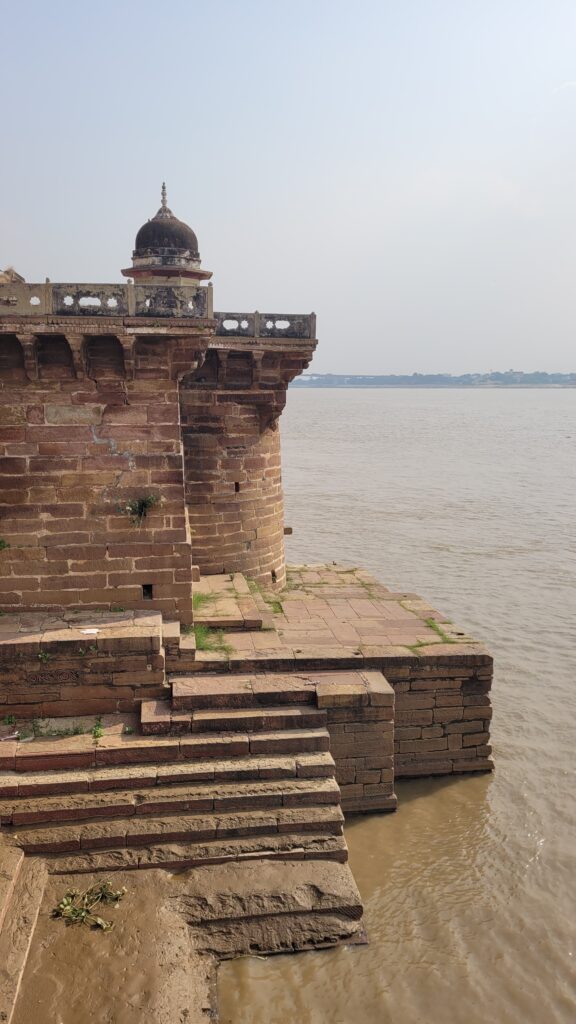
Ganga Aarti at Dasaswamedh Ghat
Our final, and particularly one of the most moving parts of the day came at dusk. This is when we made our way to Dasaswamedh Ghat. Literally translated, Dasaswamedh means the river ghat of the ten sacrificed horses, stemming from an actual sacrifice completed in the second century by the Bhara Shiva rulers. This ghat is the oldest and by some accounts, the most spectacular, as it is the site of the nightly Agni Pooja or Ganga Aarti.

Reaching Dasaswamedh Ghat was quite the adventure, as we had to navigate through throngs and throngs of people to reach the banks. Without any trace of exaggeration, we traveled literally elbow-to-elbow within a packed mass of people. Finally, when we arrived atop the stairs of the ghat, we snaked through the rest of the crowd and descended the steps to the boats, which, again, like that morning, would be our viewing place for the aarti.
As we were waiting for the religious rites to begin, there was a little commotion in the neighboring boat. In a matter of seconds, I heard a scream and instinctively turned to see a small boy – perhaps 8 or 9 years old- who had fallen into the water! Immediately, a human chain was formed to rescue the young child. Although this incident occurred in a flash, it was quite shocking!
Anyway… after perhaps 10-15 minutes, the aarti began. It must have been 6:00 PM by this time, and the sun had set. Seven priests draped in saffron puja dresses emerged carrying large plates with large brass aarti lamps. These diya-filled plates cast the skies in a golden haze! What a mind blowing sight! I felt alive… as if I was in heaven! During the puja, the priests chanted several mantras and rotated the plates with the lamps in a clockwise direction, offering their prayers to the Ganga Deity. Although normally the lamps would be released into the river, to resemble tiny lit stars, on that particular day, the aarti took place at a height above the waters. So, we did not get the chance to see this sight. Regardless, it was still a stunning, powerful and deeply moving scene to behold!
Enjoying a Traditional Bihari Dinner: Baati Chokha
Following our one-of-a-kind spiritual experience, we traveled to a traditional Bihari restaurant to meet some of my mother’s school friends (a close group!). The restaurant we visited, called Baati Chokha, serves thalis, or plates, of traditional north indian cuisine, including bread rolls filled with onion/paneer, yogurt/raita, daal-rice and pickle. The village-like ambience offered a different type of environment that made one feel as if s(he) were dining within an old town. It was also very well designed & decorated, I might add! Below are some photos of the restaurant!
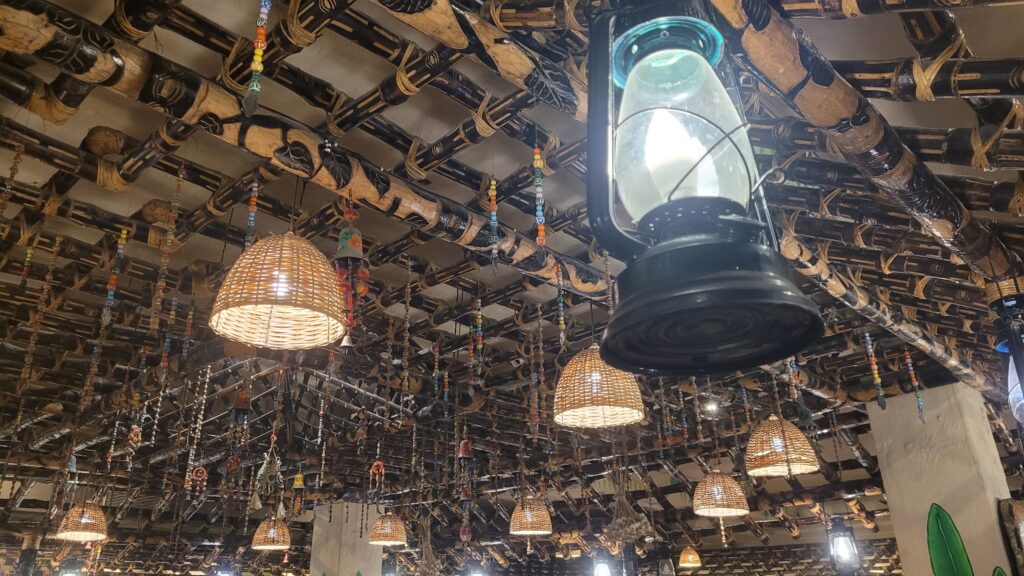

Dinner concluded around 11:00 PM, at which point we (groggily) departed with our driver, and returned to our hotel for a short snooze: the next day we were to awake at 3:00 AM for another especially significant spiritual awakening (more to come)…
And that’s a wrap on our first two days! See my next post for days three and four (another couple jam-packed days)! Thank You, as always, for following along, readers 🙂
Keep Traveling… And Exploring… <3 <3 <3
